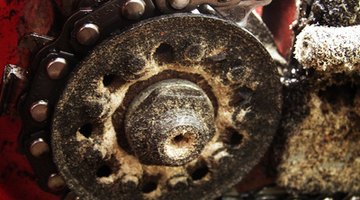How to Repair a Stihl Chainsaw
Stihl saws have hundreds of parts, all operating in conjunction with each other, that can all break down and need replacing. However, most of these parts deal with only three things: spark, air compression and fuel.

By isolating your problem in one of these three categories, you will be able to quickly locate the problem and fix the saw.
Things You Will Need
- Leather working gloves
- Wrench
- Screwdriver
- Gasoline
- Rag
- Toothbrush
- Allen wrench
Tip
Let a professional Stihl saw mechanic perform these tests if you are unfamiliar with how your engine works. If these tests don't solve your problem, there is probably a problem inside the engine itself.
Ignition Test
-
Remove the spark plug’s rubber adapter and use the spark plug wrench to take out the spark plug. Check to make sure the rubber plug and wire aren’t damaged in any way.
-
Clean the spark plug with the gas and toothbrush. Scrape off all of the deposits from the tip and gap. Wipe down with the rag.
-
Install the spark plug into the rubber plug. Let the wire and spark plug hang loose next to a metal spot on the engine’s body.
-
Pull the starter cord slowly and look for a spark across the metal points. If there isn’t a spark, replace the spark plug and repeat test.
-
Remove the spark plug wire and check the starter coil. Replace them if damaged.
Air Test
-
Remove the air filter cover and the air filter. Clean the air filter with gas, toothbrush and rag. Get rid of as much debris from the air filter’s screen as you can. Replace if old or too dirty to clean.
-
Use the Allen wrench to remove the muffler’s cover. Pull out the spark arresting screen from inside the muffler. Clean the screen and replace if damaged.
-
Pull on the starter cord to determine if your saw has compression. If the saw has compression, the engine will make a whirring and chugging noise. If there is no compression, use the screwdriver to remove the starter cover.
-
Make sure the pull cord is properly attached to the rewind string. Replace the cord if it is heavily frayed or damaged.
-
Clean inside the starter housing area with the gas, toothbrush and rag.
Fuel Test
-
Remove the gas cap and inspect the fuel filter; replace if clogged or dirty. Check the fuel lines for any cracks or holes; replace any damaged lines.
-
Clean the gas tank with the toothbrush and rag if it is dirty.
-
Take off the air filter cover and air filter again. Depress the throttle to open the carburetor (little swinging flap that opens when throttled). Spray starter fluid into the hole.
-
Remove, disassemble and clean the entire carburetor. Replace any worn parts and seals. Replace carburetor if it is heavily damaged.
-
Refill tank with fresh gas with a 50:1 gas-oil ratio.
Bar and Chain Repair
-
Remove the clutch cover, chain and bar from the saw. Inspect the bar’s sprocket tip to ensure it spins freely around the bar.
-
Pull off the E-clip washer that attaches the flywheel to the clutch. Remove the sprocket and washer and replace if heavily worn down.
-
Inspect the clutch drum for heavy damage and replace if necessary.
-
Use clutch removal tool to remove the clutch. Inspect the clutch spring and clutch for any damage. Replace only if necessary.
-
Pull off the clutch assembly and inspect the oil pump for any damage. If extremely dirty or damaged. Unscrew the oil pump's mounting screws and pull off the oil pump. Disassemble and clean the oil pump if there are noticeable problems, like cracks or leaking. Replace the worm drive, drive sprocket and oil plug. Lubricate these parts before reinstalling the oil pump.
The Drip Cap
- Stihl saws have hundreds of parts, all operating in conjunction with each other, that can all break down and need replacing.
- Remove the spark plug’s rubber adapter and use the spark plug wrench to take out the spark plug.
- Clean the spark plug with the gas and toothbrush.
- Get rid of as much debris from the air filter’s screen as you can.
- Replace if old or too dirty to clean.
- If the saw has compression, the engine will make a whirring and chugging noise.
- Remove the gas cap and inspect the fuel filter; replace if clogged or dirty.
- Take off the air filter cover and air filter again.
- Replace only if necessary.
- Pull off the clutch assembly and inspect the oil pump for any damage.
References
Writer Bio
Currently based in Minneapolis, Minn., Eric Blankenburg has been a freelance journalist since 2000. His articles have appeared in "Outside Missoula, Outside Bozeman," "Hello Chengdu" and online at GoNomad.com and various other websites. He holds a Bachelor of Arts in creative writing from the University of Montana.
Photo Credits
- chain saw image by Pali A from Fotolia.com
- chain saw image by Pali A from Fotolia.com
More Articles
- How to Troubleshoot a Poulan Chain Saw That Won't Start
- How to Clean & Repair Carburetors on Briggs & Stratton Small Engines
- How to Troubleshoot a Grasshopper Lawn Mower
- How to Repair the Clutch on a Craftsman 358 42CC 18'' Chain Saw
- Troubleshooting a Hard to Start MS 290 Stihl Chainsaw
- My Troy Bilt Pressure Washer Will Not Start



